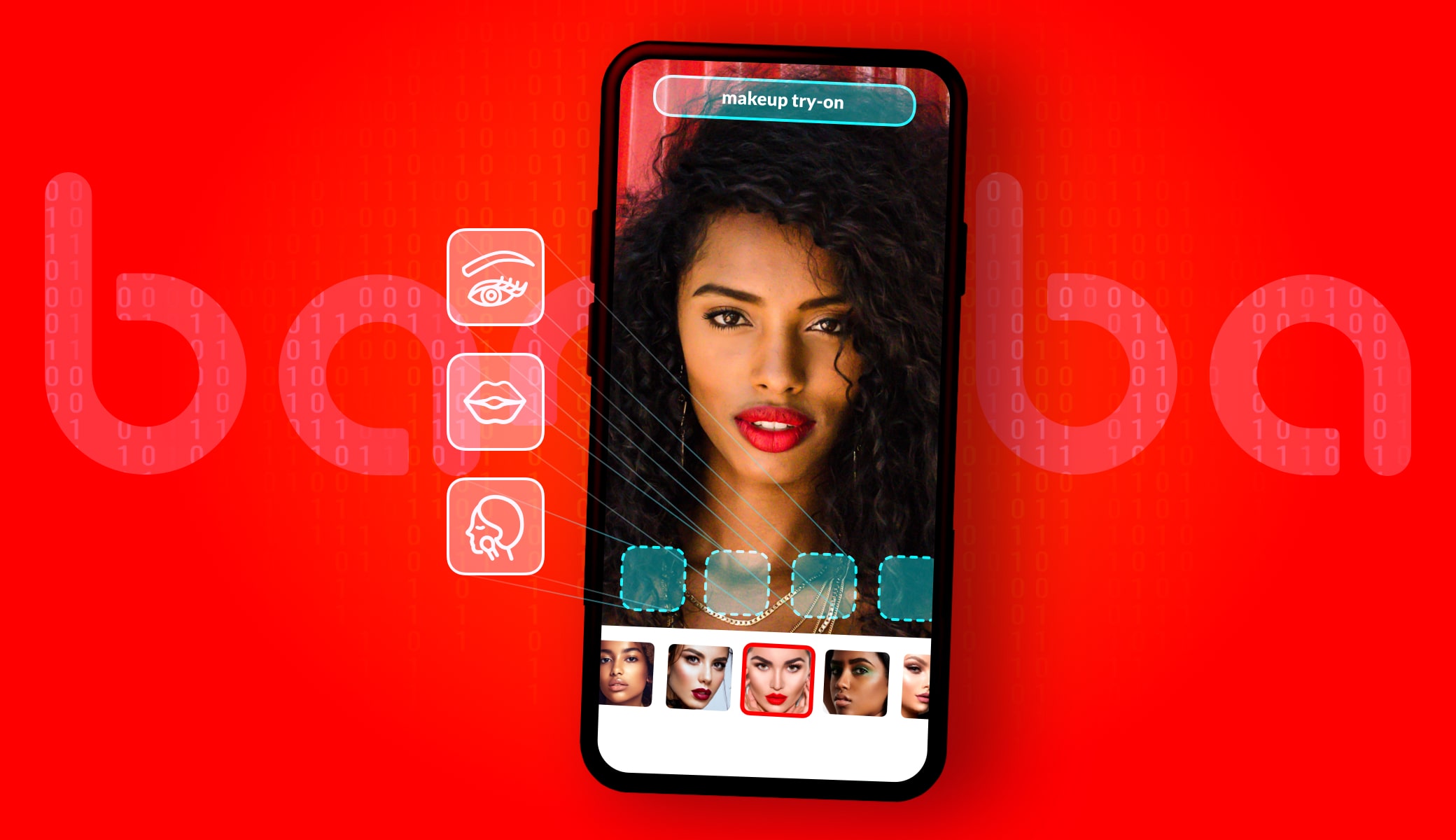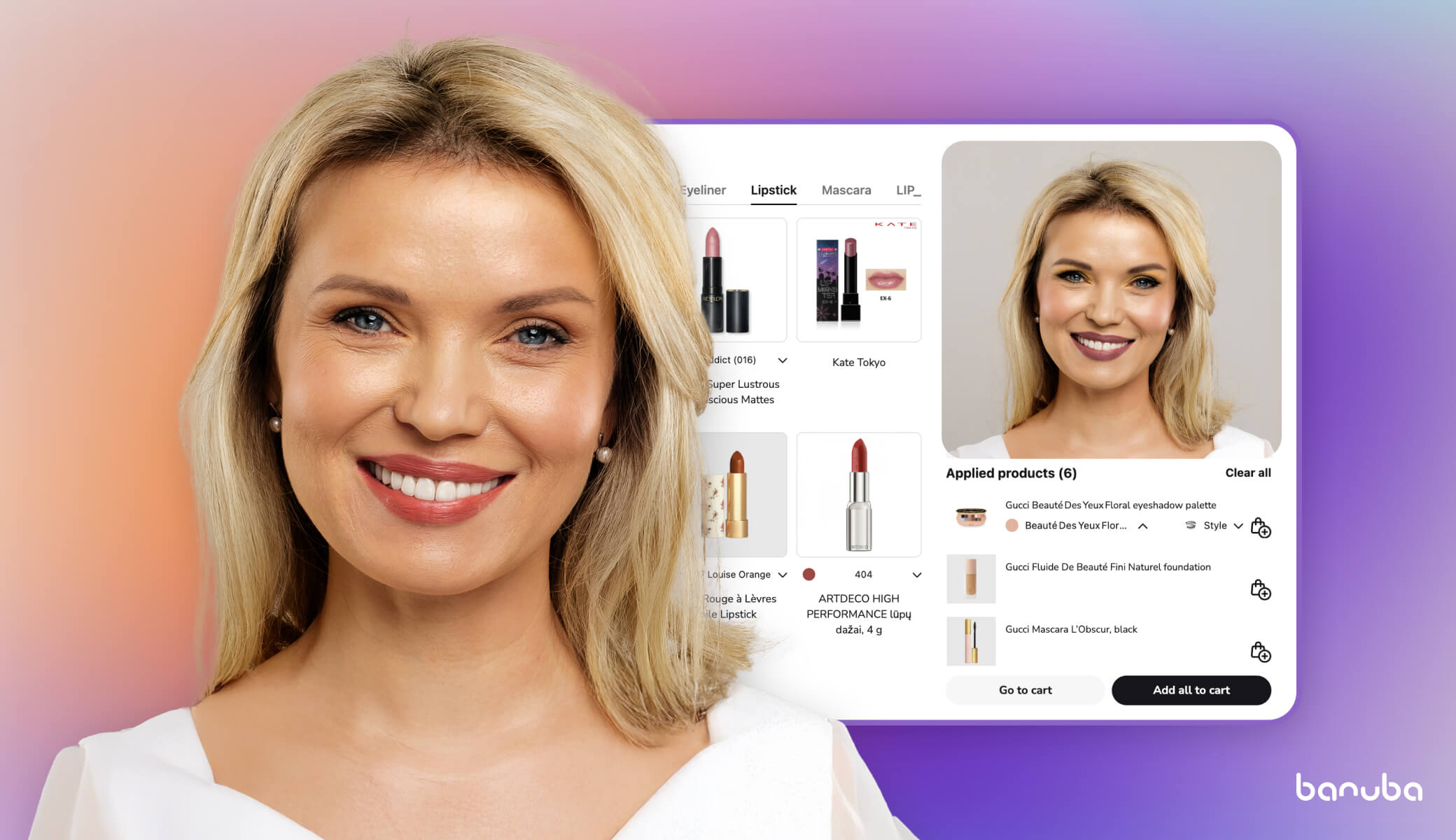2024 Beauty Ecommerce Trends

[navigation]
TL;DR
- Augmented Reality (AR) and AI beauty innovations are revolutionizing how consumers shop online, offering virtual try-ons and personalized experiences for the beauty industry eCommerce.
- Sustainability and clean beauty practices are gaining traction, with eco-friendly products and ingredient transparency driving consumer demand.
- AI in beauty industry streamlines operations through personalized recommendations, AI makeup suggestions, and chatbots for enhanced customer experience.
- Influencer marketing and user-generated content are key drivers of sales, with a shift toward micro-influencers and authentic product demonstrations.
- Beauty subscription boxes and membership programs continue to grow, offering customization and exclusive perks for beauty enthusiasts.
Brief Overview of the Beauty Industry eCommerce
The beauty industry has witnessed a remarkable shift in recent years, with ecommerce emerging as a game-changer that has transformed how consumers discover and purchase beauty products. In 2024, online sales of health and beauty brands are expected to occupy over 1/4 of the beauty industry market: the 2023 trend is continuing.
For the e-commerce giant Amazon, beauty became the fastest-growing product category, increasing by almost 25%. Sephora, one of the world's leading beauty retailers after Ulta Beauty, has successfully capitalized on the beauty ecommerce boom. It won the race among beauty ecommerce websites, with virtual sales reaching 2.3 billion dollars.
The undoubted trigger for the blazing development of digital shopping was the pandemic in 2019. Beauty brands had to face the challenge of virtual sales and adapt their growth strategies to the needs and expectations of beauty shoppers.
But now the pandemic label has been lifted from Covid, and the beauty industry has outplayed everyone and reinvented ecommerce. We must admit it has been a success since virtual sales have more than doubled since the pandemic began.
But what should beauty brands expect and keep up with in 2024? Let's dive into the beauty ecommerce trends.
Augmented Reality (AR) Beauty Experiences
In recent years, the integration of Augmented Reality (AR) technology in beauty ecommerce has transformed how consumers interact with and experience beauty products. AR technology overlays virtual elements in the real world, providing a seamless and interactive digital experience. Beauty brands have harnessed the power of AR to create innovative and engaging platforms that enhance the customer journey.
Advantages of AR in Enhancing the Customer Experience
The integration of AR technology in beauty ecommerce offers numerous advantages in enhancing the overall customer experience:
Personalization: AR allows customers to personalize their online shopping experience by virtually trying on products that match their specific preferences, skin tone, or style. This level of personalization creates a more tailored and engaging experience, increasing customer satisfaction and loyalty.
Accessibility and Convenience: AR-powered virtual try-on eliminates the need for customers to visit physical stores to try out products. This accessibility and convenience make beauty eCommerce more inclusive and accessible to a wider audience, regardless of location.
Product Exploration and Discovery: AR features encourage customers to explore and discover new products. By virtually trying on different shades or experimenting with different skincare products, customers can step out of their comfort zone and discover new favorites, ultimately driving sales for beauty brands.
Social Sharing and Engagement: AR experiences in beauty ecommerce often come with social sharing capabilities. Customers can capture and share their virtual makeovers or skincare transformations on social media platforms, leading to increased brand visibility, engagement, and potential viral marketing.
Virtual Try-on Features for Makeup and Skincare Beauty Brands
Virtual try-on technology has become one of the most prominent beauty ecommerce trends. These features let customers see how different makeup shades, such as lipstick, eyeshadow, or foundation, would look on their face or skin tone. Similarly, virtual try-on allows customers to experiment with skincare products and visualize the potential benefits for their skin.
By leveraging AR-powered virtual try-on tools like Tint from Banuba, beauty brands can address a common pain point for online shoppers - the inability to test products physically.
This technology provides a realistic representation of how products will look and perform, giving customers the confidence to make purchase decisions. Additionally, virtual try-on features can save time and minimize product returns, enhancing customer satisfaction.
AI in Beauty Industry: Personalization, Inclusion, and Customization
In the ever-evolving landscape of beauty ecommerce, personalization, inclusion, and customization have emerged as key beauty ecommerce trends shaping the beauty market in 2024. With the help of advanced artificial intelligence (AI) algorithms, online beauty brands are leveraging customer data to provide personalized recommendations, enhance inclusivity, and offer customizable experiences.
AI-driven Algorithms for Personalized Recommendations
AI in beauty industry helps to set trends. Gone are the days of generic product recommendations in beauty ecommerce. With AI-driven algorithms, beauty brands can now analyze vast amounts of customer data, including browsing history, purchase behavior, and individual preferences, to deliver highly personalized product recommendations.
These algorithms consider various factors such as skin type, tone, hair type, and personal style to curate tailored suggestions for each customer. By understanding customer preferences and offering relevant product recommendations, cosmetics brands can create a more engaging and personalized shopping experience in beauty ecommerce.
Thus, the AI-powered virtual try-on platform Tint offers a smart advisor who analyzes individual features and preferences to provide the best-matching AI makeup recommendations.
Statistics indicate the effectiveness of personalized recommendations in driving customer engagement and sales. According to a study by Accenture, 91% of consumers are more likely to shop with brands that provide relevant offers and recommendations.
Sustainable and Clean Beauty
As consumers become more conscious of their environmental impact and the ingredients they use on their skin, sustainable and clean beauty has emerged as a significant trend in the beauty ecommerce industry in 2024.
This shift towards sustainability is driven by growing consumer demand for eco-friendly products, the rise of ingredient transparency, and brands adopting sustainable practices and certifications. It includes the manufacturing process, packaging, delivery, testers, etc.
Consumers are increasingly prioritizing sustainable and clean beauty products, seeking options that are effective and environmentally friendly. According to a survey conducted by Nielsen, 73% of global consumers say they would change their consumption habits to reduce their environmental impact. In the beauty industry, this has translated into a rising demand for products that are ethically sourced, cruelty-free, and free from harmful chemicals.
The demand for sustainable and clean beauty is further supported by statistics. The Natural and Organic Cosmetics Market is projected to grow at a CAGR of 9.76% from 2021 to 2027, reaching $33.04 billion by 2027. This demonstrates the significant market opportunity for brands prioritizing sustainability and clean formulations.
Lush Cosmetics is a prime example of a brand that has embraced sustainable and clean beauty. They use minimal packaging, favoring naked products, and encourage customers to bring back empty containers for recycling. Lush also promotes ingredient transparency by clearly listing all ingredients used in their products, purpose, and origin. Their commitment to sustainability has resonated with consumers, contributing to their success in the beauty ecommerce market.
Beauty Influencers and Brand Partnerships
As social media continues to dominate the digital landscape, influencers have emerged as trusted authorities, impacting consumer purchasing decisions and driving sales. Statistics highlight the significant impact of influencers on consumer behavior. According to a survey conducted by Influencer Marketing Hub, 61% of consumers trust influencer opinions as much as their friends. Meta also states that 71%% of consumers have purchased a product based on an influencer's recommendation.
Recognizing the power of influencer marketing, cosmetic brands are increasingly partnering with influencers to promote their products and reach a wider audience. These collaborations take various forms, including sponsored content, ambassadorships, and co-creation of products.
Strategic brand-influencer partnerships allow brands to tap into the influencer's loyal following and leverage their expertise to promote products authentically. This approach increases beauty brand visibility and generates social proof and credibility. Collaborations often involve exclusive discount codes, limited-edition beauty products, or unique collaborations to entice beauty shoppers and create a sense of urgency.
However, there is a shift in trends. While macro-influencers are still sharing their skincare routines doing miracles, customers tend to trust micro-influencers and user-generated content more. In fact, the latter had more influence on 42% of buyers.
Being tired of polished images without any flaws, taken in perfect lighting with the help of makeup artists, about 61% of Americans admitted they trusted real-life product demonstrations more. Glossier beauty store rocks the authenticity and UGC, using images created by their customers to promote their products.
Social media platforms play a pivotal role in driving sales within the beauty ecommerce landscape. Platforms like Instagram, YouTube, and TikTok serve as an online store where influencers and brands connect with their target audience, showcase products, and drive engagement.
The rise of short-form video content on platforms like TikTok has also revolutionized how beauty products are marketed. Snappy tutorials, product reviews, and viral challenges have the potential to reach millions of viewers and drive substantial sales.
Beauty Subscription Boxes and Membership Programs
Beauty subscription boxes and membership programs have gained immense popularity in 2024. According to a report by McKinsey, the subscription ecommerce market has grown by more than 100% annually over the past five years, and 1/3 of Americans have a subscription from a retailer. The convenience, product discovery, cost savings, and exclusive perks they offer make them attractive options for beauty enthusiasts.
Through innovations such as customization, tiered memberships, and community engagement, subscription services continue to enhance customer loyalty and satisfaction. As the beauty ecommerce landscape evolves, these subscription-based models provide a unique and engaging way for customers to indulge in the beauty world while enjoying curated experiences tailored to their preferences.
Birchbox, a renowned beauty subscription service, has successfully implemented customization and community engagement in its subscription model. Subscribers can personalize their monthly boxes by selecting product preferences and beauty goals. Birchbox also hosts events and workshops, encouraging subscribers to connect and share their experiences.
Artificial Intelligence (AI) and Chatbots
According to a report by Grand View Research, the global AI market is expected to reach nearly $1.812 billion by 2030, growing at a compound annual growth rate (CAGR) of 37.3%. This statistic highlights AI's significant role in shaping the future of beauty ecommerce sites. And if we narrow it down to the AI beauty industry, it’s expected to bloom at a CAGR of 20.1% till 2031.
AI in beauty industry is transforming virtual sales by enabling beauty ecommerce brands to streamline operations, enhance customer experiences, and drive business growth. With AI-powered tools and algorithms, brands can gather valuable insights, optimize marketing strategies, and deliver personalized recommendations to beauty shoppers.
Besides, AI is revolutionizing how skincare is approached in the beauty ecommerce industry. Advanced algorithms and machine learning techniques are used to analyze individual skin conditions, concerns, and preferences, providing personalized skincare recommendations.
Thus, a new feature from Tint virtual try-on platform, the skin care effect, analyzes people's skin and forecasts how a certain skincare brand product would affect the individual in both long- and short-term perspectives.
Automated Customer Service through Chatbots
Chatbots have become a game-changer in customer service for beauty ecommerce companies. These AI-powered virtual assistants can handle customer inquiries, provide product information, and assist with purchasing decisions, all in real time.
The benefits of chatbots are manifold. They offer 24/7 customer support, ensuring that customers can access assistance whenever they need it. Moreover, chatbots provide instant responses, reducing customer wait times (and 53% of customers find it irritating) and increasing overall satisfaction. According to statistics, 74% of users would use a chatbot for solving simple issues or tracking orders.
Chatbots are also cost-effective for businesses in the ecommerce beauty industry. They can handle multiple customer queries simultaneously, reducing the need for a large customer service team and ultimately saving operational costs. Thus, introducing chatbot reduces the expences on customer support by 30%.
Omnichannel Approach in Beauty Ecommerce
An omnichannel strategy integrates various online and offline channels to create a seamless and cohesive shopping journey for customers. While combining physical and digital channels seems like a challenging task for a beauty retailer, Glossier, which started as an online store, occasionally steps out from the digital counter and offers an in-store experience.
In fact, the onmi approach is not just about combining an old-school brick and mortar with a cosmetic ecommerce website. It means offering more touchpoints through various sources to increase consumer spending and, eventually, brand loyalty.
How to Slay As a Beauty Ecommerce Brand?
Creating an online beauty store is not enough in 2024 to have ecommerce sales and become successful in the cosmetics industry. Business owners must be aware of the relevant beauty ecommerce trends and tendencies to keep up with their competitors and attract more customers.
One of the key steps to skyrocketing in beauty ecommerce is leveraging off-the-shelf advanced tech solutions and partnering up with service providers who can help online cosmetic companies keep up with the trends and offer clients a seamless and hyper-personalized approach.
Developing dedicated AR solutions and AI in beauty industry from scratch is still the prerogative of leading beauty giants like L’Oreal. They have the resources to obtain tech startups and invest in high-end beauty tech.
How Can Tint Help Beauty Companies Be Trendy?
Tint virtual try-on platform can revolutionize any beauty website and help keep up with every beauty ecommerce trend mentioned above. The solution uses patented segmentation and facial tracking technologies, allowing it to produce a result indistinguishable from the work of a makeup artist.
The smart beauty advisor boosts hyper-personalization through tailored AI beauty product suggestions, while the AI face analyzer, seasonal color analysis, and AI makeup recommendation feature can help customers choose the perfect filling for the subscription box, still keeping the items inside a secret.
The virtual try-one feature from Tint can become an alternative to testers, thus eliminating gas emissions and plastic waste, making a brand more sustainable. Besides, the software has the fastest makeup line digitalization time (48 hours) to add to its vast product catalog. Meaning brands can offer a try-on of a new beauty product before it hits the shelves.
Buyers' interaction with Tint can become an additional touchpoint, communication channel, and source for creating UGC to share online. And its smart advisor is available 24/7 to find the perfect match for that red dress or beautiful green eyes.
In addition to keeping up with beauty industry ecommerce trends, Tint can bring a beauty business to a brand new level of customer engagement, boost the conversion rate by 300%, and enhance the AOV by 30%.






